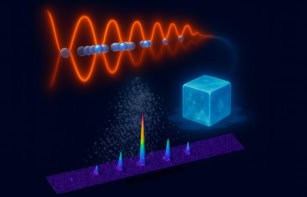Physicists in the US have weighed objects with a mass of just 10-18 grams (attograms) for the first time. Harold Craighead and colleagues at Cornell University made their measurements on small gold dots using a nanoelectromechanical device. The new sensitivity far exceeds the best previous result, which was on the femtogram (10-15 grams) scale. The team hopes their device will be able to detect and identify tiny chemical and biological species, such as viruses (R Ilic et al. 2004 J. Appl. Phys. 95 3694).

The nanoelectromechanical device used by Craighead and colleagues consists of an oscillating cantilever made from a small wafer of silicon 4 microns long and 500 nanometres wide. When a small particle is absorbed onto the wafer, it alters the frequency at which the wafer vibrates. The team was able to monitor this change by measuring laser light reflected off the wafer, which then allowed the mass of the particle to be calculated.
Using this technique, the physicists were able to “weigh” small gold dots, and coatings of molecules on the dots, with masses in the attogram range (see figure). Last year, researchers at the Oak Ridge National Lab in the US reported on being able to detect particles on the femtogram mass scale using a similar technique.
The Cornell researchers predict that their cantilever will be able to measure masses as small as 0.39 attograms. They would now like to improve on this by further reducing the size of the device. This could lead to a sensitivity in the zeptogram range (10-21 ), they speculate, and allow them to detect viruses.
In 2001, Craighead’s group measured the mass of a single bacterium – which is around 1 picogram (10-12 grams) – with its oscillating cantilever.



